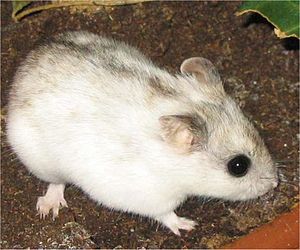Gray dwarf hamster
| Gray dwarf hamster | ||||||||||||
|---|---|---|---|---|---|---|---|---|---|---|---|---|

Chinese hamster ( Cricetulus barabensis griseus ), bright cultivated form |
||||||||||||
| Systematics | ||||||||||||
|
||||||||||||
| Scientific name | ||||||||||||
| Cricetulus | ||||||||||||
| Milne-Edwards , 1867 |
The Gray hamster or gray hamster ( Cricetulus ) are a genus of hamsters , are included among the six types. Because of external similarities with rats , these animals are called Ratlike Hamsters ("rat-like hamsters"); in German usage, however, another species is listed as the rat-like dwarf hamster that does not belong to this genus.
features
These hamsters reach body lengths of 75 to 120 millimeters, plus a tail of 20 to 50 millimeters. Their long fur is usually gray on the upper side, sometimes with a reddish tinge. The underside as well as the paws and the tip of the tail are light gray or white. Some species can also have a white pattern, one species, the Daurian dwarf hamster, has a dark eel line . All species have a stocky build with comparatively short legs. The head is characterized by the blunt snout and the large cheek pouches.
distribution and habitat
Gray dwarf hamsters are native to Eurasia , their range extends from Southeast Europe over large parts of Central Asia to northern East Asia . Their habitat are dry regions such as steppes and semi-deserts, they also occur in mountainous countries up to 3600 meters above sea level.
Way of life
Gray dwarf hamsters live in self-dug burrows that can extend up to 1.2 meters into the ground. In these burrows they sleep and store their food supplies. The animals tend to be nocturnal, but in spring and summer they also go looking for food during the day. During the cold season, they do not hibernate continuously, but wake up from time to time to eat stored food. They are likely to live solitary and be very aggressive towards other species.
They feed primarily on seeds and shoots, their preferred foods include soybeans, peas and millet grains. They also occasionally eat insects, and captive animals are reported to have also killed and consumed frogs and jerboa. The cheek pouches are very large and allow large amounts of food to be transported to the building. A single animal was found once with 42 soybeans in its cheek pouches.
Up to three or four times a year the female gives birth to five to six (in exceptional cases up to ten) young after a gestation period of around 17 to 22 days. Most births fall between February and October. The young grow quickly and are fully grown by two months.
Systematics
The genus of the gray dwarf hamster is divided into eight species:
- The gray hamster ( Cricetulus migratorius ) is distributed from the Balkan Peninsula and southern Russia and Kazakhstan to northern China and Mongolia .
- The Daurian dwarf hamster ( Cricetulus barabensis ) differs from the other species by a dark eel line . His homeland is southern and southeastern Siberia , Mongolia, northern China and Korea . The Chinese dwarf hamster , which is widespread as a domestic and laboratory animal, is sometimes listed as a separate species ( Cricetulus griseus ), but is considered to be specific to the Daurian dwarf hamster. The Transbaikal dwarf hamster ( Cricetulus pseudogriseus ), which is sometimes viewed as a separate species, is also a subspecies of the Daurian dwarf hamster according to recent studies.
- The Sokolov dwarf hamster ( Cricetulus sokolovi ) is native to Mongolia and Inner Mongolia .
- The long-tailed dwarf hamster ( Cricetulus longicaudatus ) differs from the other species in that it has a longer tail that gives it its name. The species lives in Mongolia and neighboring parts of Russia ( Altai region and Tuva ) as well as in northern and western China.
- The four species of the Tibetan dwarf hamsters (subgenus Urocricetus ) inhabit the highlands of Tibet , the extreme north of India and the west of Nepal .
The genera of the medium-sized dwarf hamsters ( Allocricetulus ), Gansu dwarf hamsters ( Cansumys ) and rat-like dwarf hamsters ( Tscherskia ) were sometimes listed as sub-genera of Cricetulus in the past , but are now recognized as genera of their own.
literature
- Ronald M. Nowak: Walker's Mammals of the World. 2 volumes. 6th edition. Johns Hopkins University Press, Baltimore MD et al. 1999, ISBN 0-8018-5789-9 .
- Don E. Wilson , DeeAnn M. Reeder (Eds.): Mammal Species of the World. A taxonomic and geographic Reference. 2 volumes. 3. Edition. Johns Hopkins University Press, Baltimore MD 2005, ISBN 0-8018-8221-4 .
Individual evidence
- ↑ Andrew T. Smith, Robert S. Hoffmann: Subfamily Cricetinae . In: Andrew T. Smith, Xie Yan (Eds.): A Guide to the Mammals of China . Princeton University Press, Princeton / Oxford 2008, ISBN 978-0-691-09984-2 , pp. 239-247 (English; pp. 241-245).
Web links
- Endangerment level of the individual species in the IUCN Red List of Threatened Species .